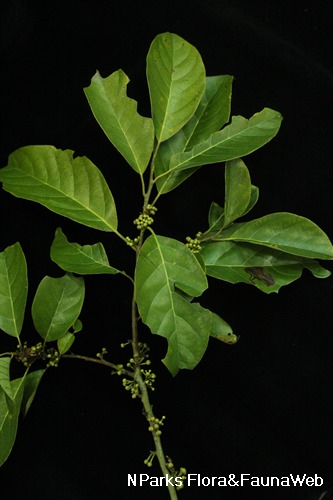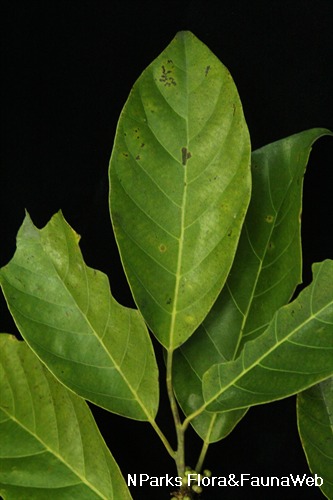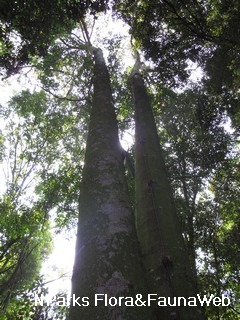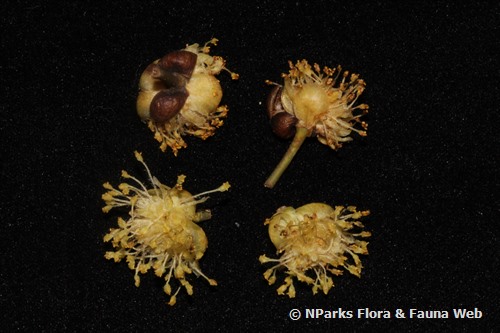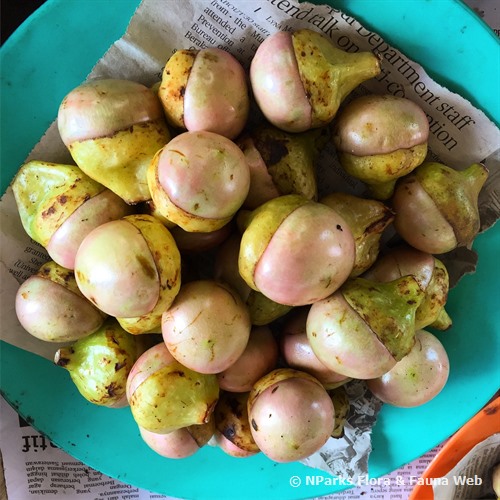
Back
Litsea elliptica Blume
| Family Name: | Lauraceae |
| Synonyms: | Litsea petiolata Hook. f. |
| Common Name: | Medang, Perawas |
Name
Classifications and Characteristics
| Plant Division | Angiosperms (Flowering Seed Plants) (Dicotyledon) |
|---|---|
| Plant Growth Form | Tree (Big (>30m)) |
| Lifespan (in Singapore) | Perennial |
| Mode of Nutrition | Autotrophic |
| Plant Shape | Irregular |
| Maximum Height | 45 m |
Biogeography
| Native Distribution | From Peninsular Malaysia, Singapore, Java, Borneo, through to New Guinea. |
|---|---|
| Native Habitat | Terrestrial (Primary Rainforest, Secondary Rainforest, Freshwater Swamp Forest) |
| Preferred Climate Zone | Tropical |
| Local Conservation Status | Native to Singapore (Least Concern (LC)) |
Description and Ethnobotany
| Growth Form | It is a buttressed tree up to 45 m tall. Its grey-brown bark is smooth and has lenticels. Its pinkish inner bark has a strong spicy smell. |
|---|---|
| Foliage | Its alternate, stalked leaves have thinly leathery leaf blades that are elliptic to narrowly drop-shaped and about 6–14 by 2–6.5 cm. Its midribs and secondary leaf veins are sunken on the upper surface of the leaf blade. Its ladder-like tertiary leaf veins are parallel to each other. |
| Flowers | Its flowering clusters arise from the leaf axils or the bare twigs. Its flower petals are covered with hair. |
| Fruit | Its spherical to elliptic fruits are up to 7 mm across, ripening red, with a cup on top. |
| Habitat | It grows mainly at lowland forests. It occurs locally in Central Catchment Nature Reserve, Changi, Nee Soon Swamp Forest, along Old Upper Thomson Road, Pulau Tekong, and Pulau Ubin. |
| Associated Fauna | Its flowers are insect-pollinated. Its fruits are eaten by birds and small mammals. |
| Cultivation | It can be propagated by seed. |
| Etymology | Litsea, from the Chinese names ‘li’ and ‘tse’, which mean little plum; Latin elliptica, elliptic, alluding to the shape of the plant’s leaf blade |
| Ethnobotanical Uses | Medicinal: Its aromatic bark has
medicinal properties and is used as a native medicine. Cultural / Religious: Heritage Tree : There is currently one individual of Litsea elliptica listed as a Heritage Tree in Singapore. It can be found on Sentosa. To find out more about this tree, please visit the Heritage Tree Register. |
Landscaping Features
| Landscaping | It may be suitable for parks. |
|---|---|
| Desirable Plant Features | Ornamental Fruits |
| Landscape Uses | General, Suitable for Roadsides, Parks & Gardens, Small Gardens, Reforestation |
Fauna, Pollination and Dispersal
| Fauna Pollination Dispersal Associated Fauna | Bird-Attracting |
|---|---|
| Pollination Method(s) | Biotic (Fauna) |
| Seed or Spore Dispersal | Biotic (Fauna) |
Plant Care and Propagation
| Light Preference | Full Sun, Semi-Shade |
|---|---|
| Water Preference | Moderate Water |
| Plant Growth Rate | Moderate |
| Rootzone Tolerance | Moist Soils, Well-Drained Soils, Fertile Loamy Soils |
| Propagation Method | Seed |
Foliar
| Foliage Retention | Evergreen |
|---|---|
| Mature Foliage Colour(s) | Green |
| Mature Foliage Texture(s) | Leathery |
| Foliar Type | Simple / Unifoliate |
| Foliar Arrangement Along Stem | Alternate |
| Foliar Attachment to Stem | Petiolate |
| Foliar Shape(s) | Non-Palm Foliage (Elliptical) |
| Foliar Venation | Pinnate / Net |
| Foliar Margin | Entire |
Floral (Angiosperm)
| Flower & Plant Sexuality | Bisexual Flowers |
| Flower Colour(s) | Cream / Off-White, White, Yellow / Golden |
|---|---|
| Flower Grouping | Cluster / Inflorescence |
| Flower Location | Axillary |
Fruit, Seed and Spore
| Mature Fruit Colour(s) | Green |
|---|---|
| Fruit Classification | Simple Fruit |
Image Repository
Others
| Master ID | 31230 |
|---|---|
| Species ID | 5625 |
| Flora Disclaimer | The information in this website has been compiled from reliable sources, such as reference works on medicinal plants. It is not a substitute for medical advice or treatment and NParks does not purport to provide any medical advice. Readers should always consult his/her physician before using or consuming a plant for medicinal purposes. |

